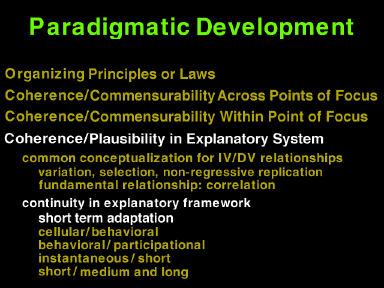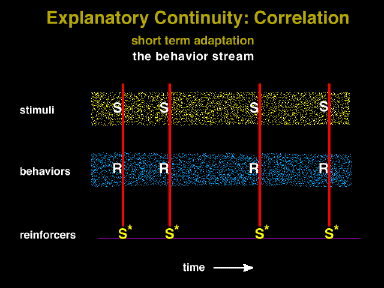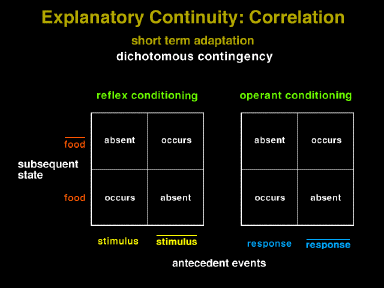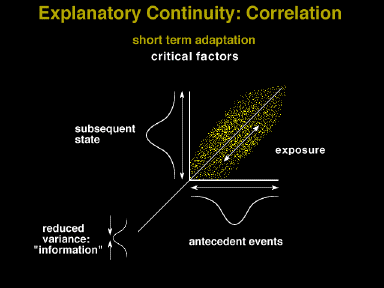 Slide 5-27
Slide 5-27

 Slide 5-27
Slide 5-27
It seems that, as a minimum, the diversity in the unit domain and the time domain can, in fact, be conceptualized in a common way, if not described as the result of a common process. The conceptualization of the underlying process as correlation can be used to better understand both how the elements of the structure emerged and also the functional relationships within the paradigmatic structure.
 Slide 5-28
Slide 5-28
First, let's look at short-term behavioral adaptation or 'learning'. In this case the correlation is between an antecedent event (stimulus or response) and the subsequent state or consequence.
 Slide 5-29
Slide 5-29
The task of short-term behavioral adaptation is to select the events that should "go together" from the nearly infinite number of events in nature. How are particular elements selected out of the many? As can be seen, given the "behavior stream" and its "stimulus bed," it is relatively easy to argue that stimuli and or behaviors which are correlated with reinforcers come to be "connected." or extracted. Much as a signal averager extracts a systematic signal from noise.
 Slide 5-30
Slide 5-30
It can be seen that correlation properly describes both reflex and operant conditioning. It's not simply that a stimulus and a response are followed by a contiguous reinforcer, but that the events are correlated. The absence of the events also goes together.
 Slide 5-31
Slide 5-31
This slide illustrates a more general case. It depicts a correlation between normally distributed continuous dimensions rather than a simple 2 by 2 contingency. As can be seen, various aspects of some antecedent event (e.g., locations of a response) are associated with variations of some subsequent states (e.g., quantities of food), while other events (e.g., singing) are uncorrelated, orthogonal or irrelevant. Given that correlation describes "information" in the environment, then any mechanism which functions as the result of correlation then becomes an "information-dependent" mechanism. A simple twist of a phrase makes the organism an "information-seeking" mechanism. If subsequent states are more or less adaptive, then individuals which react appropriately to anything which is correlated with those subsequent states will be more adaptive and will come to predominate in the population. Continuous elements provide for partial solutions or a continuous path to potentially very extreme alternatives. The four critical elements for correlation driven adaptation are 1) difference in antecedent events, 2) difference in subsequent states 3) exposure to various conjunctions and 4) resulting reduced variance or information.
There is additional information available on this topic.

